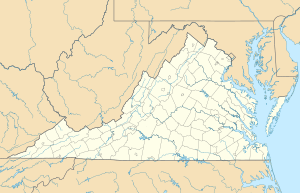Three Creek facts for kids
Quick facts for kids Three Creek |
|
|---|---|
| Other name(s) | Tributary to Nottoway River |
| Country | United States |
| State | Virginia |
| County | Greensville Southampton Sussex |
| City | Emporia |
| Physical characteristics | |
| Main source | Confluence of Tryall Creek and Cooks Branch about 2 miles north of Pleasant Shade, Virginia about 168 feet 36°47′16″N 077°38′13″W / 36.78778°N 77.63694°W |
| River mouth | confluence with the Nottoway River about 1/2 mile west of Sebrell, Virginia about 15 feet amsl 36°46′53″N 077°09′50″W / 36.78139°N 77.16389°W |
| Length | 75.4 km/46.9 miles |
| Basin features | |
| Progression | roughly east |
| River system | Nottoway River |
| Tributaries |
|
| Waterbodies | Slagles Lake |
| Bridges | Greensville County Routes 605, 613, 619, 610, 617, I-95, US 301, Greensville County Route 616, Sussex County Route 611, Southampton County Routes 615, 659, 308, 609 (Crichton Bridge) |
Three Creek is a river in southeastern Virginia, United States. It flows for almost 47 miles (75.4 km) and is a tributary (a smaller stream that flows into a larger one) of the Nottoway River.
Contents
Where Does Three Creek Flow?
Three Creek starts where two smaller streams, Tryall Creek and Cooks Branch, meet in Greensville County, Virginia. From there, it flows east and then south into a place called Slagles Lake.
After leaving Slagles Lake, the creek continues south for about a mile. Then, it turns and flows generally southeast and northeast through swampy areas. It keeps going until it reaches the Nottoway River. For some of its journey, Three Creek forms the border between Greensville and Sussex Counties.
What is the Three Creek Watershed Like?
The watershed is all the land area that drains water into a river or creek. Three Creek's watershed is mostly covered by forests. It also has a lot of swampy land, especially closer to the Nottoway River. Farming is another big part of the land use in this area.
How Has Three Creek Been Changed?
Three Creek has one impoundment (a place where water is held back, usually by a dam) along its path, which is Slagles Lake. Some of the smaller streams that flow into Three Creek also have their own impoundments.
What is the Geology of Three Creek?
The area where Tryall Creek and Cooks Branch meet is in the Piedmont region of Virginia. This area has rocks that were formed from ancient volcanoes.
- Tryall Creek starts in an area with granite rock.
- Cooks Branch begins where there is granite gneiss (a type of rock similar to granite but with layers).
As Three Creek flows, it moves into the Coastal Plain region. Here, it passes through an area with a type of rock called the Bacon Castle Formation. For most of its length, especially in the swampy parts, the creek flows over alluvium. Alluvium is a mix of sand, silt, and clay that rivers deposit over time.


